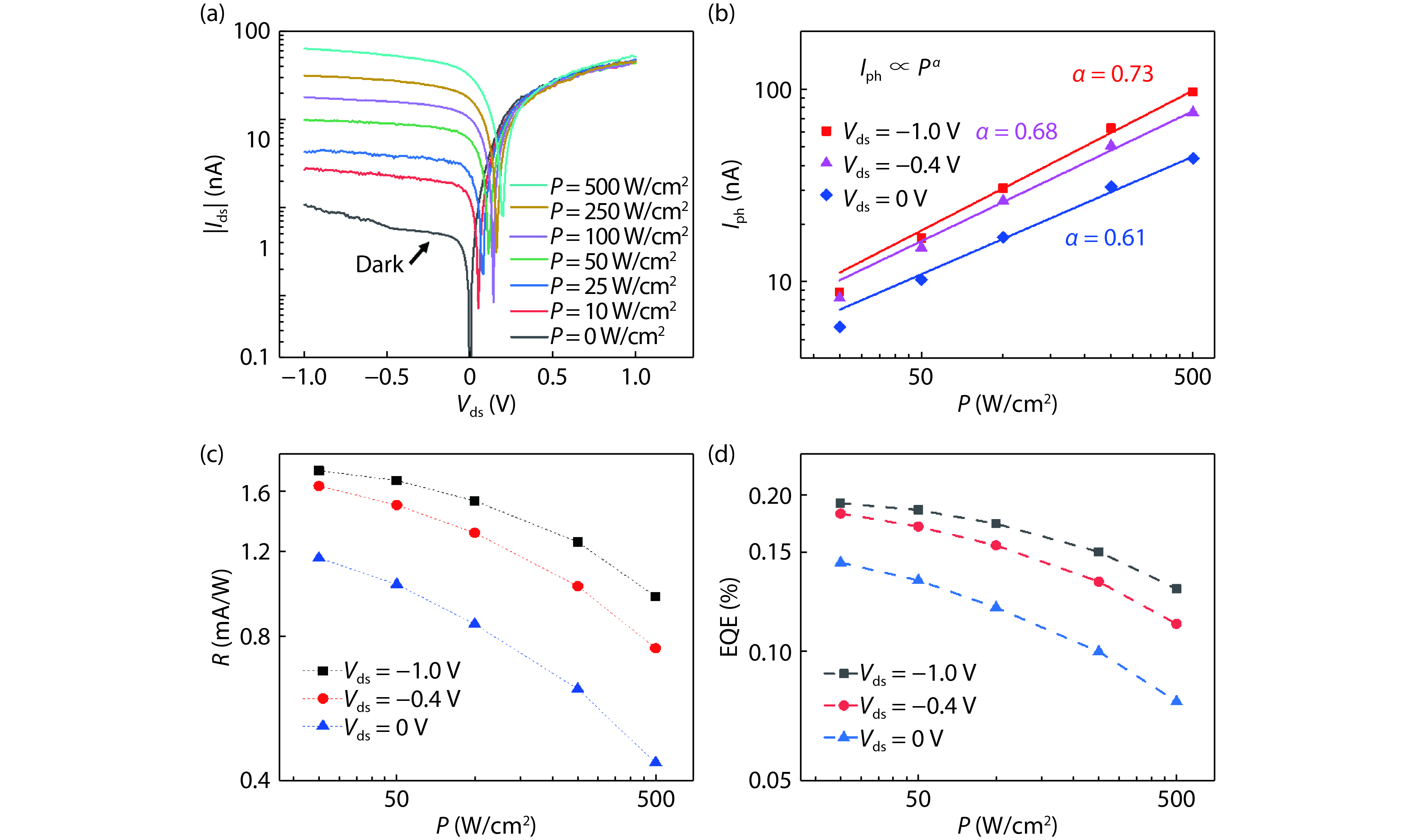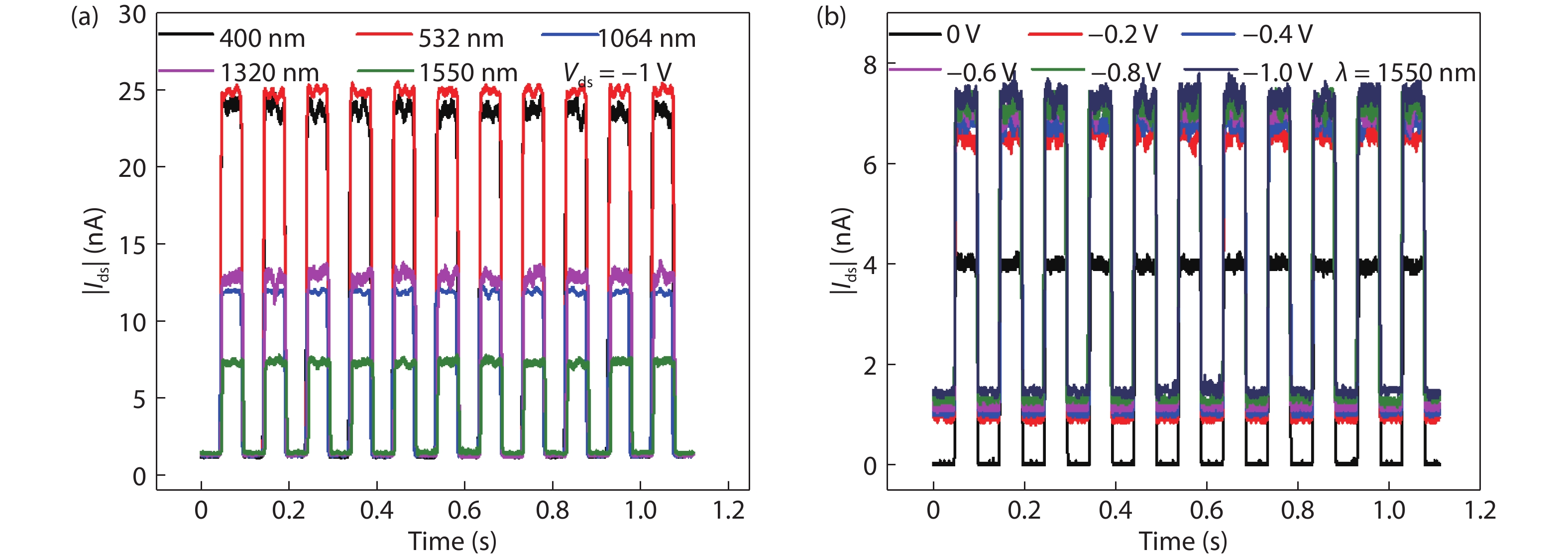| Citation: |
Wenkai Zhu, Xia Wei, Faguang Yan, Quanshan Lv, Ce Hu, Kaiyou Wang. Broadband polarized photodetector based on p-BP/n-ReS2 heterojunction[J]. Journal of Semiconductors, 2019, 40(9): 092001. doi: 10.1088/1674-4926/40/9/092001
****
W K Zhu, X Wei, F G Yan, Q Lv, C Hu, K Y Wang, Broadband polarized photodetector based on p-BP/n-ReS2 heterojunction[J]. J. Semicond., 2019, 40(9): 092001. doi: 10.1088/1674-4926/40/9/092001.
|
Broadband polarized photodetector based on p-BP/n-ReS2 heterojunction
DOI: 10.1088/1674-4926/40/9/092001
More Information
-
Abstract
Two-dimensional (2D) atomic crystals, such as graphene, black phosphorus (BP) and transition metal dichalcogenides (TMDCs) are attractive for use in optoelectronic devices, due to their unique crystal structures and optical absorption properties. In this study, we fabricated BP/ReS2 van der Waals (vdWs) heterojunction devices. The devices realized broadband photoresponse from visible to near infrared (NIR) (400–1800 nm) with stable and repeatable photoswitch characteristics, and the photoresponsivity reached 1.8 mA/W at 1550 nm. In addition, the polarization sensitive detection in the visible to NIR spectrum (532–1750 nm) was demonstrated, and the photodetector showed a highly polarization sensitive photocurrent with an anisotropy ratio as high as 6.44 at 1064 nm. Our study shows that van der Waals heterojunction is an effective way to realize the broadband polarization sensitive photodetection, which is of great significance to the realization and application of multi-functional devices based on 2D vdWs heterostructures. -
References
[1] Novoselov K S, Geim A K, Morozov S V, et al. Electric field effect in atomically thin carbon films. Science, 2004, 306(5696), 666 doi: 10.1126/science.1102896[2] Li L, Yu Y, Ye G J, et al. Black phosphorus field-effect transistors. Nat Nanotechnol, 2014, 9, 372 doi: 10.1038/nnano.2014.35[3] Vogt P, De Padova P, Quaresima C, et al. Silicene: compelling experimental evidence for graphenelike two-dimensional silicon. Phys Rev Lett, 2012, 108(15), 155501 doi: 10.1103/PhysRevLett.108.155501[4] Gomes L C, Carvalho A. Phosphorene analogues: Isoelectronic two-dimensional group-IV monochalcogenides with orthorhombic structure. Phys Rev B, 2015, 92(8), 085406 doi: 10.1103/PhysRevB.92.085406[5] Splendiani A, Sun L, Zhang Y, et al. Emerging photoluminescence in monolayer MoS2. Nano Lett, 2010, 10(4), 1271 doi: 10.1021/nl903868w[6] Wang Q H, Kalantar-Zadeh K, Kis A, et al. Electronics and optoelectronics of two-dimensional transition metal dichalcogenides. Nat Nanotechnol, 2012, 7, 699 doi: 10.1038/nnano.2012.193[7] Cao Y, Cai K, Hu P, et al. Strong enhancement of photoresponsivity with shrinking the electrodes spacing in few layer GaSe photodetectors. Sci Rep, 2015, 5, 8130 doi: 10.1038/srep08130[8] Luo W, Cao Y, Hu P, et al. Gate tuning of high-performance InSe-based photodetectors using graphene electrodes. Adv Opt Mater, 2015, 3(10), 1418 doi: 10.1002/adom.201500190[9] Schaibley J R, Yu H, Clark G, et al. Valleytronics in 2D materials. Nat Rev Mater, 2016, 1, 16055 doi: 10.1038/natrevmats.2016.55[10] Akinwande D, Petrone N, Hone J. Two-dimensional flexible nanoelectronics. Nat Commun, 2014, 5, 5678 doi: 10.1038/ncomms6678[11] Feng Q, Yan F, Luo W, et al. Charge trap memory based on few-layer black phosphorus. Nanoscale, 2016, 8(5), 2686 doi: 10.1039/C5NR08065G[12] Rao C N R, Gopalakrishnan K, Maitra U. Comparative study of potential applications of graphene, MoS2, and other two-dimensional materials in energy devices, sensors, and related areas. ACS Appl Mater Interfaces, 2015, 7(15), 7809 doi: 10.1021/am509096x[13] Pizzocchero F, Gammelgaard L, Jessen B S, et al. The hot pick-up technique for batch assembly of van der Waals heterostructures. Nat Commun, 2016, 7, 11894 doi: 10.1038/ncomms11894[14] Konstantatos G, Sargent E H. Nanostructured materials for photon detection. Nat Nanotechnol, 2010, 5, 391 doi: 10.1038/nnano.2010.78[15] Gong C, Zhang Y, Chen W, et al. Electronic and optoelectronic applications based on 2D novel anisotropic transition metal dichalcogenides. Adv Sci, 2017, 4(12), 1700231 doi: 10.1002/advs.v4.12[16] Tyo J S, Goldstein D L, Chenault D B, et al. Review of passive imaging polarimetry for remote sensing applications. Appl Opt, 2006, 45(22), 5453 doi: 10.1364/AO.45.005453[17] Yan F, Wei Z, Wei X, et al. Toward high-performance photodetectors based on 2D materials: strategy on methods. Small Methods, 2018, 2(5), 1700349 doi: 10.1002/smtd.v2.5[18] Wei X, Yan F G, Shen C, et al. Photodetectors based on junctions of two-dimensional transition metal dichalcogenides. Chin Phys B, 2017, 26(3), 038504 doi: 10.1088/1674-1056/26/3/038504[19] Ye L, Wang P, Luo W, et al. Highly polarization sensitive infrared photodetector based on black phosphorus-on-WSe2 photogate vertical heterostructure. Nano Energy, 2017, 37, 53 doi: 10.1016/j.nanoen.2017.05.004[20] Tran V, Soklaski R, Liang Y, et al. Layer-controlled band gap and anisotropic excitons in few-layer black phosphorus. Phys Rev B, 2014, 89(23), 235319 doi: 10.1103/PhysRevB.89.235319[21] Zhou Z, Cui Y, Tan P H, et al. Optical and electrical properties of two-dimensional anisotropic materials. J Semicond, 2019, 40(6), 061001 doi: 10.1088/1674-4926/40/6/061001[22] Qiao J, Kong X, Hu Z X, et al. High-mobility transport anisotropy and linear dichroism in few-layer black phosphorus. Nat Commun, 2014, 5, 4475 doi: 10.1038/ncomms5475[23] Yuan H, Liu X, Afshinmanesh F, et al. Polarization-sensitive broadband photodetector using a black phosphorus vertical p–n junction. Nat Nanotechnol, 2015, 10, 707 doi: 10.1038/nnano.2015.112[24] Zhang E, Jin Y, Yuan X, et al. ReS2-based field-effect transistors and photodetectors. Adv Funct Mater, 2015, 25(26), 4076 doi: 10.1002/adfm.v25.26[25] Rahman M, Davey K, Qiao S Z. Advent of 2D rhenium disulfide (ReS2): fundamentals to applications. Adv Funct Mater, 2017, 27(10), 1606129 doi: 10.1002/adfm.v27.10[26] Tongay S, Sahin H, Ko C, et al. Monolayer behaviour in bulk ReS2 due to electronic and vibrational decoupling. Nat Commun, 2014, 5, 3252 doi: 10.1038/ncomms4252[27] Pradhan N R, McCreary A, Rhodes D, et al. Metal to insulator quantum-phase transition in few-layered ReS2. Nano Lett, 2015, 15(12), 8377 doi: 10.1021/acs.nanolett.5b04100[28] Lin Y C, Komsa H P, Yeh C H, et al. Single-layer ReS2: two-dimensional semiconductor with tunable in-plane anisotropy. ACS Nano, 2015, 9(11), 11249 doi: 10.1021/acsnano.5b04851[29] Liu F, Zheng S, He X, et al. Highly sensitive detection of polarized light using anisotropic 2D ReS2. Adv Funct Mater, 2016, 26(8), 1169 doi: 10.1002/adfm.v26.8[30] Liu E, Long M, Zeng J, et al. High responsivity phototransistors based on few-layer ReS2 for weak signal detection. Adv Funct Mater, 2016, 26(12), 1938 doi: 10.1002/adfm.201504408[31] Cao S, Xing Y, Han J, et al. Ultrahigh-photoresponsive UV photodetector based on a BP/ReS2 heterostructure p–n diode. Nanoscale, 2018, 10(35), 16805 doi: 10.1039/C8NR05291C[32] Li X K, Gao X G, Su B W, et al. Polarization-dependent photocurrent of black phosphorus/rhenium disulfide heterojunctions. Adv Mater Interfaces, 2018, 5(22), 1800960 doi: 10.1002/admi.v5.22[33] Castellanos-Gomez A, Buscema M, Molenaar R, et al. Deterministic transfer of two-dimensional materials by all-dry viscoelastic stamping. 2D Mater, 2014, 1(1), 011002 doi: 10.1088/2053-1583/1/1/011002[34] Perello D J, Chae S H, Song S, et al. High-performance n-type black phosphorus transistors with type control via thickness and contact-metal engineering. Nat Commun, 2015, 6, 7809 doi: 10.1038/ncomms8809[35] Shim J, Oh S, Kang D H, et al. Phosphorene/rhenium disulfide heterojunction-based negative differential resistance device for multi-valued logic. Nat Commun, 2016, 7, 13413 doi: 10.1038/ncomms13413[36] Jo S H, Lee H W, Shim J, et al. Highly efficient infrared photodetection in a gate-controllable Van der Waals heterojunction with staggered bandgap alignment. Adv Sci, 2018, 5(4), 1700423 doi: 10.1002/advs.v5.4[37] Massicotte M, Schmidt P, Vialla F, et al. Picosecond photoresponse in van der Waals heterostructures. Nat Nanotechnol, 2015, 11, 42 doi: 10.1038/nnano.2015.227[38] Xue Y, Zhang Y, Liu Y, et al. Scalable production of a few-layer MoS2/WS2 vertical heterojunction array and its application for photodetectors. ACS Nano, 2016, 10(1), 573 doi: 10.1021/acsnano.5b05596[39] Lv Q, Yan F, Wei X, et al. High-performance, self-driven photodetector based on graphene sandwiched GaSe/WS2 heterojunction. Adv Opt Mater, 2018, 6(2), 1700490 doi: 10.1002/adom.v6.2[40] Yan F, Zhao L, Patane A, et al. Fast, multicolor photodetection with graphene-contacted p-GaSe/n-InSe van der Waals heterostructures. Nanotechnology, 2017, 28(27), 27L doi: 10.1088/1361-6528/aa749e[41] Wei X, Yan F, Lv Q, et al. Fast gate-tunable photodetection in the graphene sandwiched WSe2/GaSe heterojunctions. Nanoscale, 2017, 9(24), 8388 doi: 10.1039/C7NR03124F[42] Wei X, Yan F, Lv Q, et al. Enhanced photoresponse in MoTe2 photodetectors with asymmetric graphene contacts. Adv Opt Mater, 2019, 0(0), 1900190[43] Wu W, Zhang Q, Zhou X, et al. Self-powered photovoltaic photodetector established on lateral monolayer MoS2-WS2 heterostructures. Nano Energy, 2018, 51, 45 doi: 10.1016/j.nanoen.2018.06.049[44] Liu H, Xu B, Liu J M, et al. Highly efficient and ultrastable visible-light photocatalytic water splitting over ReS2. Phys Chem Chem Phys, 2016, 18(21), 14222 doi: 10.1039/C6CP01007E[45] Huang S, Ling X. Black phosphorus: optical characterization, properties and applications. Small, 2017, 13(38), 1700823 doi: 10.1002/smll.201700823[46] Ling X, Huang S, Hasdeo E H, et al. Anisotropic electron-photon and electron-phonon interactions in black phosphorus. Nano Lett, 2016, 16(4), 2260 doi: 10.1021/acs.nanolett.5b04540[47] Wang X, Li Y, Huang L, et al. Short-wave near-infrared linear dichroism of two-dimensional germanium selenide. J Am Chem Soc, 2017, 139(42), 14976 doi: 10.1021/jacs.7b06314 -
Proportional views






 DownLoad:
DownLoad:



















